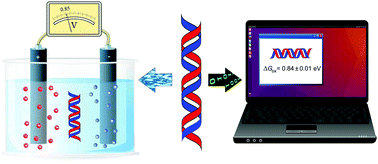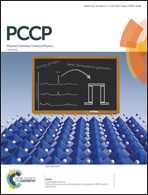Modeling DNA oxidation in water†
Abstract
A novel set of hole-site energies and electronic coupling parameters to be used, in the framework of the simplest tight-binding approximation, for predicting DNA hole trapping efficiencies and rates of hole transport in oxidized DNA is proposed. The novel parameters, significantly different from those previously reported in the literature, have been inferred from reliable density functional calculations, including both the sugar-phosphate ionic backbone and the effects of the aqueous environment. It is shown that most of the experimental oxidation free energies of DNA tracts and of oligonucleotides available from photoelectron spectroscopy and voltammetric measurements are reproduced with great accuracy, without the need for introducing sequence dependent parameters.

- This article is part of the themed collection: 2017 PCCP HOT Articles


 Please wait while we load your content...
Please wait while we load your content...